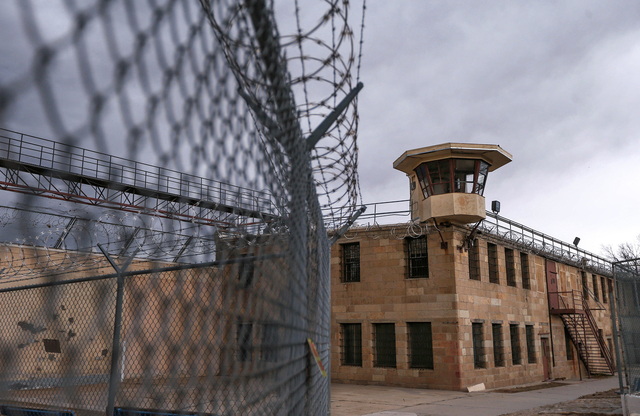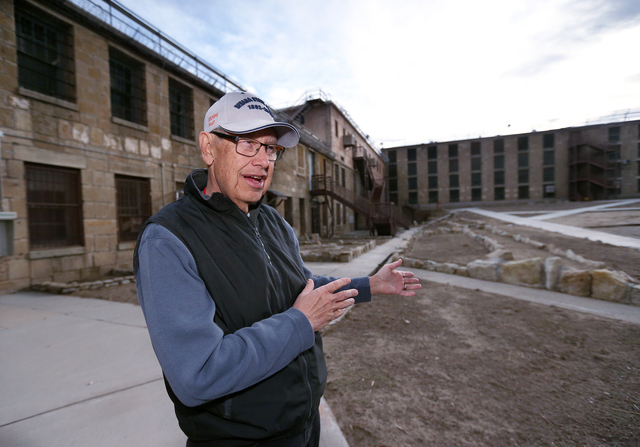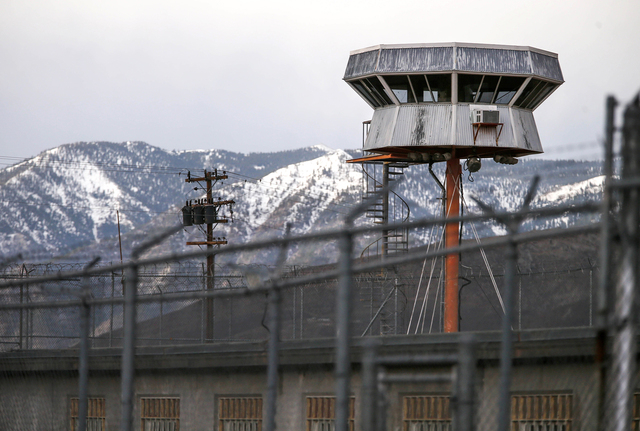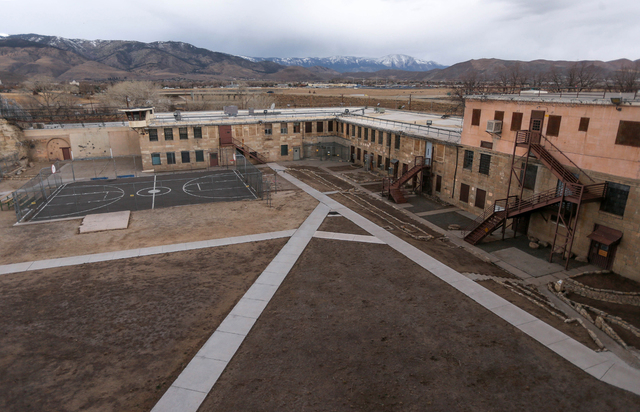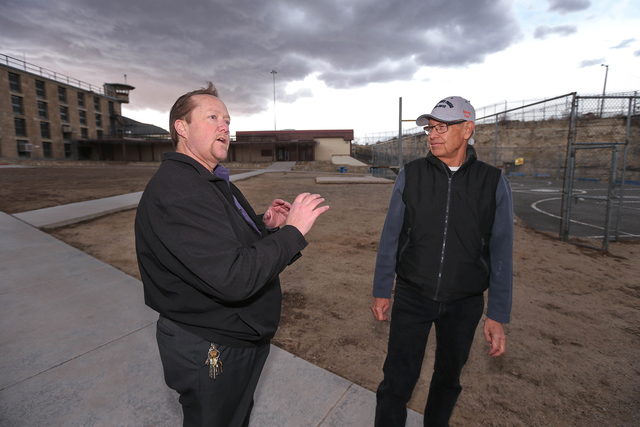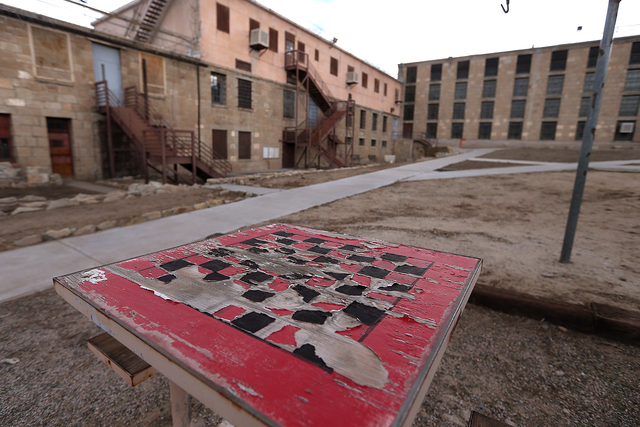Work to change historic Nevada prison to museum is going slow
CARSON CITY — Rusty gates that used to clang shut behind inmates sentenced to serve time at what was one of the West’s oldest territorial prisons might one day swing open for visitors and history buffs at the Nevada State Prison.
Closed since January 2012, the prison, much of it built of sandstone quarried on the site, is picturesque as prisons go.
The old prison yard, with cell blocks rising above it on the north and east, looks like something out of a movie. And in fact it has appeared in a few films over the years, from “State Penitentiary” in 1950 to “An Innocent Man” in 1989 starring Tom Selleck.
The west side of the yard is contained by a rock wall where the quarry operated. Caves are dug into the rock, which were used for various functions, including as a “hole” to discipline inmates.
A Gatling gun, now in the collection of the Nevada State Museum, once looked down on the yard from the west.
Glen Whorton, a retired Nevada Corrections Department official who got his start at the old prison on the east side of the capital city in 1973, is president of a group dedicated to preserving the historic facility, the Nevada State Prison Preservation Society.
While the place might seem spooky in daylight, working the graveyard shift as a young correctional officer when the prison was the state’s maximum-security facility took spooky to a whole new level, he said.
“When you walked into the yard, those windows were alive and watching you,” Whorton said.
On a recent tour, the wind blew fiercely through the old yard, kicking up sand and dust. Where once was grass and flowers tended by inmates, only dirt remains. If the group is successful in getting funding to open the facility as a museum and for tours, the gardens might return one day.
“The state of Nevada, from an administrative standpoint, essentially started out here with the Warm Springs Hotel,” Whorton said. “The prison was the first state agency.”
But creating a museum is a challenge with limited funds available for such projects.
Whorton said the group is now seeking to get the prison, which opened in 1862, on the National Register of Historic Places. The process is underway at the state level.
While the prison itself has a long history, including a famous prison break and the fact that inmates operated a casino on the premises from 1931 to 1967, offering blackjack, craps and other games of chance, its history goes back much further.
Ancient fossilized tracks of animals dating to the prehistoric era, including those believed to be a giant sloth, were discovered at the site when the stone was quarried to build the state Capitol and many other of Carson City’s historic buildings. Now covered up, the tracks might one day be part of the display at the prison, Whorton said.
Named Eagle Valley, the area was also on the Carson branch of the California Emigrant Trail long before Carson City existed.
It was on the prison site that the Warm Springs Hotel was built by Carson City’s founding father Abraham Curry in about 1860, according to the historical marker at the site. The hotel, none of which remains, was used as a meeting place for the Territorial Legislature which first formed in 1861.
In 1862, the hotel was leased by Nevada Territory and used for holding prisoners. It burned in 1867.
The only artifact remaining from the hotel is an eagle, made of wood, that is housed in the Fraternal Order of the Eagles hall in Carson City.
The prison, unlike most state agencies, is established in the state Constitution. Curry became the first warden of what was essentially the first state agency, Whorton said.
Progress toward opening the prison as a tourist attraction has been slow. The 2013 Legislature passed a bill sponsored by the late Assemblyman Pete Livermore to create a planning group to make recommendations to the 2015 Legislature on what should be done with the facility, which also has construction dating from much later periods than the territorial days.
“This is a long game,” Whorton said. “In the sense that cost is going to be an issue.”
A bill draft will be submitted to the 2015 session with a now-completed plan that would include a museum and private commercial activities in conjunction with the state’s prison industries program, called Silver State Industries, he said.
The plan could include locating some state offices at the facility, and some training opportunities, Whorton said.
The group next year will also pursue an architectural survey to determine the age of the various components of the prison, he said.
But there are other challenges. The state’s execution chamber is still housed in the closed facility, and could potentially be used again if an execution is scheduled for one of the state’s 80 or so death row inmates. The last execution was in 2006. Nevada’s death row is now at Ely State Prison in eastern Nevada.
Efforts to fund a new execution chamber at the Ely prison were unsuccessful in the 2013 legislative session.
According to a history of the death penalty prepared by the Nevada State Library and Archives, Nevada in 1921 became the first state in the U.S. to use lethal gas as a method of execution at the Nevada State Prison. The first person in Nevada and the country to be executed by lethal gas was Gee Jon, a Chinese man, on Feb. 8, 1924, for the shooting murder of a fellow countryman in a Tong war dispute in Mina.
One of the most interesting stories about the prison is known as the Great Escape of 1871, when 29 prisoners broke into an armory and grabbed pistols, rifles and ammunition and engaged in a gun battle in the prison yard. It took months to capture or kill the escapees.
Another escape made the news in 1997 because the inmate, Steve Albrecht, only had one leg. Albrecht managed to climb out of the prison, and then apparently scaled another fence at a sewage treatment plant next door, where he hot-wired a truck and crashed through a gate. He was arrested a few hours later in Mineral County.
The prison was closed in 2012 as a cost-saving measure.
Contact Capital Bureau reporter Sean Whaley at swhaley@reviewjournal.com or 775-687-3900. Follow @seanw801 on Twitter.



